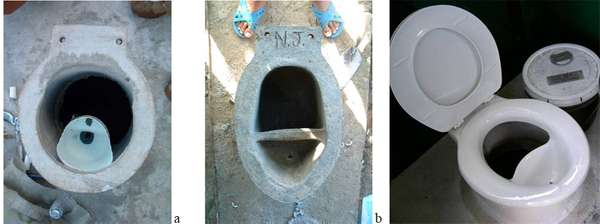Introduction
A composting toilet is any system that converts human waste into compost through the natural breakdown of organic matter. The photo above shows a composting toilet from the late 1800’s. Composting toilets provide a sanitary method to recycle human waste while conserving water and protecting the environment. In addition, they produce a valuable fertilizer. Composting toilets can be divided into batch systems and continuous use systems. The models covered here are batch systems.
Basic Design
Batch composting toilets can be divided into wet models and dry models. In both models waste is covered with a dry material (ash, lime, soil, sawdust, etc) after each use and is composted in a chamber that is plastered or sealed so that it is waterproof. In a dry composting toilet, urine is collected separately from feces.Compared to wet systems, dry composting toilets have less smell, use less dry cover and produce a regular supply of Nitrogen fertilizer. Wet composting toilets are easier to construct and produce a richer final fertilizer.
The diagram below shows a front and side view of a batch composting toilet that was built in Mbandaka, Zaire, in 1988. Essentially the basic toilet design is two chambers built side by side with a floor and a center wall separation. Chamber A is used for one year, then A will be covered and chamber B will be used for one year. At the beginning of the third year the compost from chamber A is removed and used. Chamber A is then put back in use while the contents of chamber B composts.
Double Walled Composting Toilets
Composting toilets can be designed with passive solar ventilation for better air circulation, the elimination of odor, and quicker composting action. This is accomplished by constructing a double wall on one side of the upper structure. The outer skin of the double wall should be transparent plastic material or sheet metal roofing painted black. The sun warms the air between the inner and outer walls and as the warm air rises, it draws the air from the upper part of the toilet through the pit and into the double wall, where it continues to warm and rise. A toilet without a double wall is a typical basic composting toilet.
The top step (shown as “A” below) is a removable slab for compost removal. Be certain that the roof overhang is sufficient to prevent pit back fill.

Overhead view

Front View

Double Front Wall Side View

Double Back wall. Side view
Dry Composting Toilets
 Dry composting toilets separate liquid waste from solid waste. Liquid waste is mixed with water and used as a source of Nitrogen. After each use solid waste is covered with a small amount of dry material and toilet paper is discarded in a waste bin.
Dry composting toilets separate liquid waste from solid waste. Liquid waste is mixed with water and used as a source of Nitrogen. After each use solid waste is covered with a small amount of dry material and toilet paper is discarded in a waste bin.
Dry composting toilets use the same basic composting toilet design with 2 sealed chambers and add a urine diverter and collector. The photos below show several models of urine diverters including ones constructed out of concrete and plastic containers.
Additional Resources
http://practicalaction.org/?id=water_and_sanitation
www.lifewater.org/resources/sanitation.html#SAN
www.weblife.org/humanure/index.html
www.ecosanres.org/pdf_files/ToiletsThatMakeCompost.pdf
Cite this article as:
Forst, C. 2002. Composting Toilets . ECHO Technical Note no. 47.

